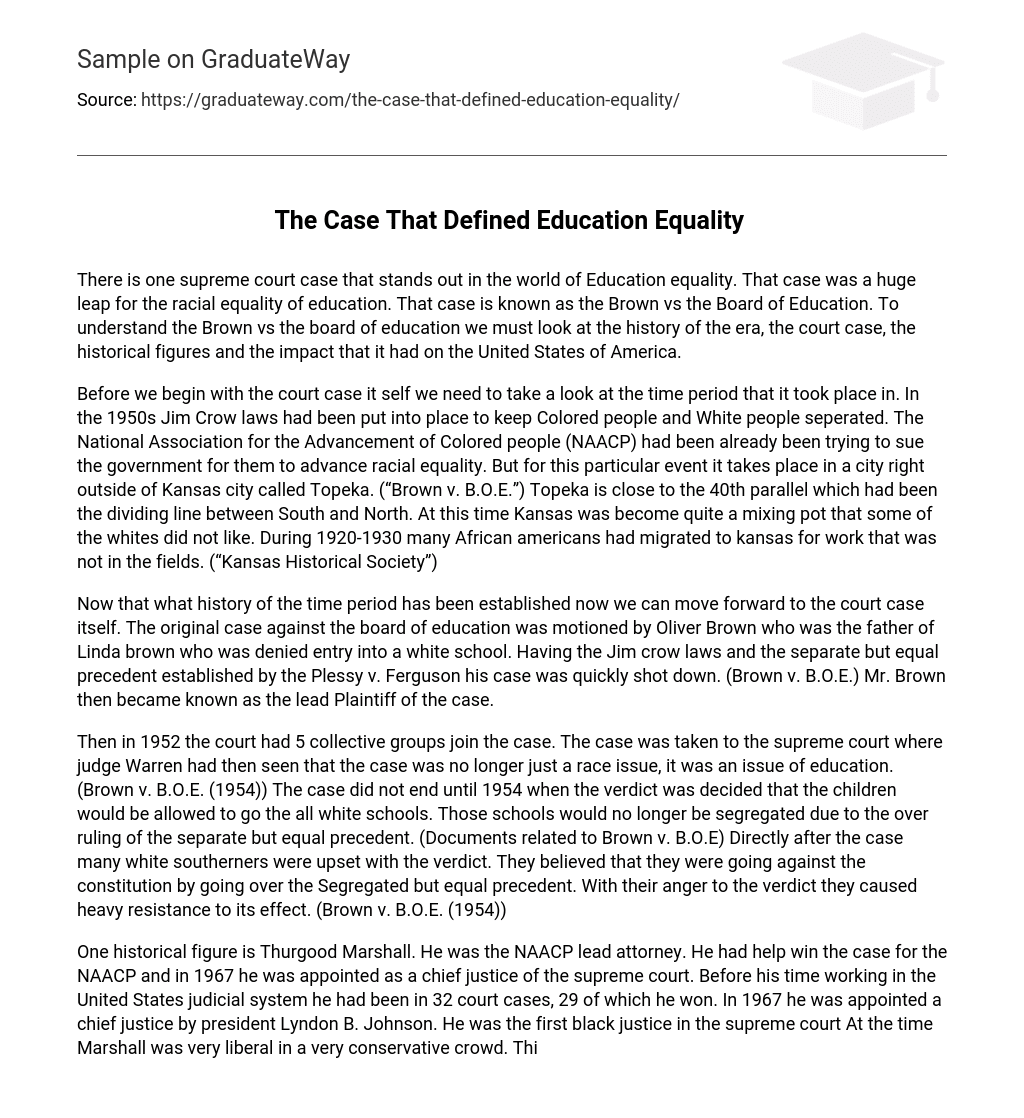There is one supreme court case that stands out in the world of Education equality. That case was a huge leap for the racial equality of education. That case is known as the Brown vs the Board of Education. To understand the Brown vs the board of education we must look at the history of the era, the court case, the historical figures and the impact that it had on the United States of America.
Before we begin with the court case it self we need to take a look at the time period that it took place in. In the 1950s Jim Crow laws had been put into place to keep Colored people and White people seperated. The National Association for the Advancement of Colored people (NAACP) had been already been trying to sue the government for them to advance racial equality. But for this particular event it takes place in a city right outside of Kansas city called Topeka. (“Brown v. B.O.E.”) Topeka is close to the 40th parallel which had been the dividing line between South and North. At this time Kansas was become quite a mixing pot that some of the whites did not like. During 1920-1930 many African americans had migrated to kansas for work that was not in the fields. (“Kansas Historical Society”)
Now that what history of the time period has been established now we can move forward to the court case itself. The original case against the board of education was motioned by Oliver Brown who was the father of Linda brown who was denied entry into a white school. Having the Jim crow laws and the separate but equal precedent established by the Plessy v. Ferguson his case was quickly shot down. (Brown v. B.O.E.) Mr. Brown then became known as the lead Plaintiff of the case.
Then in 1952 the court had 5 collective groups join the case. The case was taken to the supreme court where judge Warren had then seen that the case was no longer just a race issue, it was an issue of education. (Brown v. B.O.E. (1954)) The case did not end until 1954 when the verdict was decided that the children would be allowed to go the all white schools. Those schools would no longer be segregated due to the over ruling of the separate but equal precedent. (Documents related to Brown v. B.O.E) Directly after the case many white southerners were upset with the verdict. They believed that they were going against the constitution by going over the Segregated but equal precedent. With their anger to the verdict they caused heavy resistance to its effect. (Brown v. B.O.E. (1954))
One historical figure is Thurgood Marshall. He was the NAACP lead attorney. He had help win the case for the NAACP and in 1967 he was appointed as a chief justice of the supreme court. Before his time working in the United States judicial system he had been in 32 court cases, 29 of which he won. In 1967 he was appointed a chief justice by president Lyndon B. Johnson. He was the first black justice in the supreme court At the time Marshall was very liberal in a very conservative crowd. This made it much more difficult for him to stop what was going on.
Impact: The impact of the case has been significant because it was one of the first legal wins for the NAACP. It later led to more court victories because of the effect that it had on the Supreme court. From that point forward the it pushed judge Warren to see all the cases where were about significant issues that impacted race relations, administrative criminal justice, operation of criminal justice, and separation of church and state. In the later months and years to come, schools across America had allowed people of all races to be allowed in all schools. This all came to be after lots of resistance by white supremacist groups. (Brown v. B.O.E. (1954)) Some view the decision as one of the biggest steps that the United states education system because of the steps that it took to education equality. Today schools are full of different ethnicities and races. Those different people bring a perspective to the different issues and definitely brings something that would not have been shown in a all white school.
Now that we have a better understanding of why this case was a big step in the world of education equality we can see that it was quite amazing. The Brown vs. board of education case was very impactful on today’s modern life. The time period had a very high impact on the case it self and made lots of people go down in history. Knowing the lasting impact was on the supreme court we can start to understand why some things were passed and denied during that time period. If the case had not happened the United States would be a very different place then it is today.





